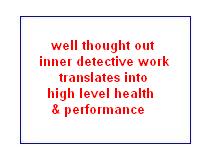Managing Mind Pacing & Self-Judging

We all go at our own pace. We all know the story of the turtle & the hare, but knowing a story & then translating it to our own actions is quite another matter. So what’s an A-type personality to do?….. Elizabeth Bohorquez, RN, C.Ht
Before beginning the mind exercise for today, I'd like to explain a bit about our thoughtWARE series of books & CD programs. The excerpts that you are reading here are taken from several different titles including those dealing with high level performance, accelerated learning, lifestyle change for disorderly eating & sugar & other addictions, as well as learning our original tools of Interactive Self-Hypnosis. We are also inviting you to listen to our complimentary mp3 downloads. These are complete Interactive Self-Hypnosis sessions taken from our work archives.In all of our books & programs, managing stress with healthy coping patterns is key. And so, pacing change is vital to all of them. Many people suffer from the need for immediate gratification that I call hurry-up disease. If you have this disease, focus on it. This will allow you to see the tendency towards compulsiveness right under the surface of the hurry up mind state. Usually this is not new for most of us, especially in sugar addicted individuals or those suffering with eating disorder. These mind states present themselves in a variety of inner programs and as you become more proficient at examining your current subconscious programs, you will find clues to their existence in the different areas of both inner and outer life. As you work to become more aware and then to edit these emotions that interfere with pacing, you will find yourself reaching even more goals, perhaps some you haven't even thought about for awhile. The subconscious mind librarian will simply pick them up off the table in the inner library and do them for you.
Most of us don't have to look far to locate the inner and outer judge aspects of ourselves. They usually hang around and whisper critical messages into our ears. As you improve the observations of your thought patterns, listening to your verbal conversations you will find this emotional crayon literally coloring overtime.
Today's work is engaging the process of waking up to judgmental mind-talk, the little voice in the head that judges this and that. Notice that some of the judgments are aimed at you and some at others or situations. Self-judgment and that of others is very much a part of the addicted personality pattern, but this is not an excuse for keeping it as is. As thought awareness improves you will begin to notice the crayon coloring your verbal conversations, things you say even without thinking. The work today is to only engage the seeing process, not to change anything dramatically. Just the seeing will enforce a change and as you continue with this work the judgmental crayon will stay in the box more often.
You might take a mental scratch pad and make a check mark every time you notice your judgmental crayon. Make one column for self-judging, another for the judging of others or situations. This is inner "detective work". You are focusing on awareness of thoughts, your body connections to these thoughts and the emotional crayons as they come to color the experiences.
MIND EXERCISE:
Just as if you had a picture in your wallet of your judgmental emotional state holding it's little crayon, go ahead and describe it , just as if it were a little child wearing a tee shirt with the word "JUDGMENT" on the front. Listen carefully so you can hear the mind and verbal chatter. Notice it is separate from you and that you are the observer. This is a powerful exercise in disassociation. When something is separate from you the act of control is easier. The emotional child is outside of you where it can be contained and educated.
_____________________________________________________________
_____________________________________________________________
Inner pictures with affirmation direction enhance new mind programs. Remember to tilt your eyes up 20 degrees and place your inner movie screen up and out before planting. It also helps to see a detailed picture with the accompanying words. In this exercise notice the building of the earlier blueprint. The inner mind is being directed to join this work together. This will enhance outcomes.
1. I notice my judgmental emotional visitor and smile at it when it visits me. Truly get into your mind screen and stand directly in front of your "visitor." This is very powerful. In the beginning you may find it difficult to face your Self in this way, but simply breathe & go for it. You won't be sorry. It's all about breaking that fear deadlock.
2. My judgmental visitor is outside of myself. I can notice it easily. When I notice it being present, I smile inwardly and then notice my breath. Here you are reaffirming that you are not your emotion. This mind-action of disassociation will allow you to move into a position of personal power. From here you will also be able to diminish the emotion, seeing it for what it is. It is no longer your inner resident.
3.I make changes in small increments. Here you have the opportunity to place a small, but powerful subconscious mind program in place. This type of program gives you the opportunity to truly change your automatic pilot programs, even if you are an A-type personality.
4. I examine my blueprint many times a day. I am excited about my plans. I enjoy change. When these short, emotionally charged affirmations are placed in your subconscious mind, you will begin to sense the power of your own inner mind.

<< Home